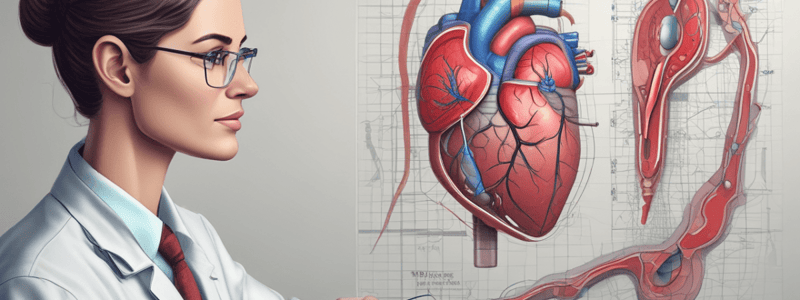Podcast
Questions and Answers
What is the primary purpose of a comprehensive physical exam?
What is the primary purpose of a comprehensive physical exam?
- To focus on a specific body system
- To provide primary prevention
- To diagnose a specific chief complaint
- To establish a baseline for future visits and assessments (correct)
In which section of the history would a cardiac stent be documented?
In which section of the history would a cardiac stent be documented?
- Review of Systems
- Chief Complaint
- History of Present Illness
- History of Subjective (correct)
What is included in the assessment section of a patient's documentation?
What is included in the assessment section of a patient's documentation?
- Chief complaint and history of present illness
- Physical exam and images
- Prescription and follow-up plans
- Diagnosis and differential diagnoses (correct)
What is the main difference between a comprehensive and focused exam?
What is the main difference between a comprehensive and focused exam?
What type of patient would typically receive a focused exam?
What type of patient would typically receive a focused exam?
What is included in the plan section of a patient's documentation?
What is included in the plan section of a patient's documentation?
What type of documentation is used in an emergency room setting?
What type of documentation is used in an emergency room setting?
What is the primary goal of a focused exam?
What is the primary goal of a focused exam?
What is the main difference between a comprehensive and focused follow-up?
What is the main difference between a comprehensive and focused follow-up?
What is the primary purpose of a comprehensive H&P?
What is the primary purpose of a comprehensive H&P?
Flashcards are hidden until you start studying
Study Notes
Cardiac System and Medical Documentation
- A patient's denial of cardiac stents is documented in the History - Subjective section, under Chief Complaint and History of Present Illness (HPI).
Medical Documentation Structure
- Chief Complaint: patient's primary concern
- History - Subjective: patient's reported information, including HPI, past medical history, and review of systems (ROS)
- Objective: exam findings, laboratory results, and available images
- Assessment: diagnosis, including primary and differential diagnoses
- Plan: treatment plan, including prescriptions, imaging or diagnostic procedures, and follow-up care
Types of Medical Encounters
- Comprehensive History and Physical (H&P): most detailed and comprehensive, used for new patients or baseline assessments
- Focused Encounter: established patient with a specific chief complaint, tailored exam and documentation
- Focused Follow-up: established patient with a specific concern, follow-up visit
- Focused Emergency: urgent visit, prioritizing acute concern over comprehensive assessment
Comprehensive History and Physical (H&P)
- Introductory Information: patient demographics, including gender, race, ethnicity, language, and accompaniment
- Past Medical History: surgical, psychiatric, and developmental history, current medications, and current health conditions
- Social, Occupational, and Family History: including genetic or hereditary risk factors (e.g., cardiac disease, psychiatric illness, cancer, hypertension, diabetes)
Studying That Suits You
Use AI to generate personalized quizzes and flashcards to suit your learning preferences.




